In today’s ecommerce landscape, email marketing automation plays a huge role in nurturing leads and increasing sales.
By sending the right message at optimal times, your brand can be at the forefront of your customer’s minds. Automated emails can guide prospects and customers through your sales process.
At the same time, pre-written email flows save time and help you engage your audience with relevant, behavior-triggered emails.
From welcoming new subscribers to recovering abandoned carts, automated emails provide scalable touchpoints. This marketing technique elevates the customer experience in a scalable way, resulting in increased sales and loyalty.
Email marketing automation provides a huge competitive advantage for ecommerce businesses.
If you want to implement this time-saving email strategy, this guide is for you. We’ll discuss the ten best automated email flows proven to boost sales and customer retention for ecommerce brands.
Let’s get started.
Benefits of email flows
Before we dive into the top email flows, you should know how they can help your business grow. Let’s take a quick review of its benefits:
- Increased sales: Email flows are great at guiding leads through your sales funnels. Marketers can use them to recover abandoned carts, cross-sell, and upsell, which typically results in higher sales.
- Improved customer engagement: Personalized, well-timed emails make your brand more trustworthy. This builds stronger customer relationships and encourages repeat purchases.
- Deeper customer insights: Email flows provide in-depth data on customer behavior and preferences. This helps you improve your email strategy and send more relevant content.
- Enhanced automation and efficiency: Automated email flows are more relevant when triggered by customer behaviors. Automation helps streamline your email efforts so no leads slip through the cracks.
- Efficient scalability: Automated email flows can scale easily to meet the dynamic needs of a growing business. This way, you don’t miss a beat in communicating with your growing customer base.
Ten essential email flows for an ecommerce business
If you’re keen on improving your email marketing game, here are our top ten picks for ecommerce email flows to maximize your marketing efforts:
1. Welcome email series
An absolute essential in ecommerce, the welcome email series sets your brand’s first impression among new subscribers. This email series aims to set expectations, build rapport, and gently encourage an initial purchase.
A typical welcome email series consists of 3–5 emails, evenly spaced out to release useful content like:
- A “thank you for subscribing” email
- Brand story and values + invitation to social media
- Popular product categories or bestsellers
- Discount code or free shipping incentive
- Reminder of the incentive
Let’s consider this welcome email by Glossier for example. This email shares the brand’s story and offers a 10% discount. This is a great way to gain new subscribers and incentivize initial purchases.
This email also promotes Glossier’s top-selling products to spark FOMO among subscribers.
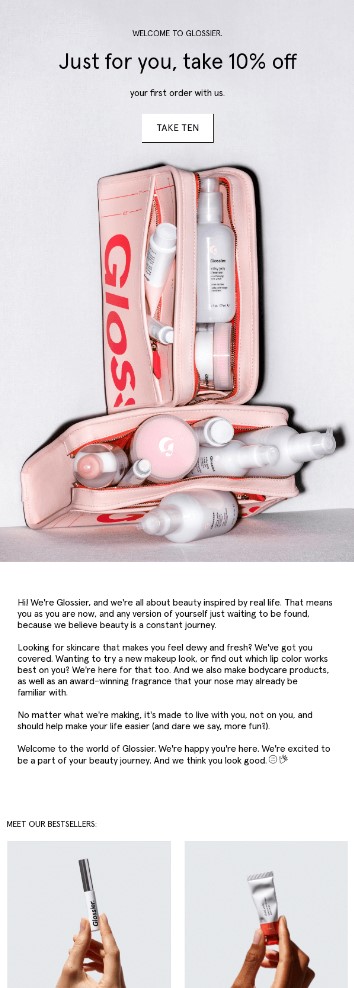
Image via Really Good Emails
This leaves a strong impression and lays the groundwork for an engaged audience eager to browse their entire offering.
With a solid welcome email series, ecommerce brands can efficiently convert fresh leads into customers receptive to future email flows for cross-sells, reorders, and more.
As we’ve seen, the welcome email series is great for building an initial relationship and trust with new subscribers. It helps you maximize the customer’s lifetime value and foster organic growth.
2. Abandoned cart emails
Cart abandonment is a reality that ecommerce brands can’t completely avoid. For context, data from Dynamic Yield shows that 73.3% of shopping carts didn’t convert into purchases.
That said, abandoned cart emails are potent revenue recoverers. According to Barilliance, this type of email can recover up to 22% of potential sales.
Reminding customers of the items they left behind may spark a fear of missing out and reignite their intention to complete the purchase. However, don’t just send one email; we suggest you send a series of evenly spaced-out cart reminder emails.
According to a Rejoiner study, sending a series of abandoned cart emails recovers more carts at a higher ROI than sending just one. What’s more, it puts your strategy ahead of 52% of the competition.
Based on the study, other factors that make your cart reminder emails more hard-hitting include:
- Subject lines
- Calls to action (CTAs)
- Email timing
- Email content
- Product recommendations
Hot sauce brand Yellowbird Sauce provides a great example of a well-scripted cart reminder email. In addition to highlighting the specific item left behind, the company further entices shoppers with free shipping and brilliantly promotes cross-sells.

Image via Really Good Emails
That said, make sure to test different tones, incentives, and timing. This helps you maximize this email flow’s ability to recover sales you’d otherwise lose.
3. Browse abandonment emails
Cart reminder emails target shoppers who started the checkout process but didn’t buy. On the other hand, browse abandonment emails are made to re-engage window shoppers who looked at your products but didn’t add them to their cart.
The goal is to remind window shoppers of products they showed interest in, so they’ll come back to buy them. These email flows are effective at achieving this.
For example, a clothing retailer collaborated with Omnisend to send browse abandonment emails. Their efforts resulted in a whopping 124% increase in their open rate and 3,536% more revenue per email (RPE).
Interestingly, these emails generated 26% of their yearly email revenue, although only accounting for less than 3% of emails sent.
This email sample by Sometimes Always, a boutique online wine shop, is a typical browse recovery email. What makes this email effective is that it compliments the shopper to pique their interest and ignites their FOMO to compel them to return.
This email also comes with a clickable CTA, making it easier for the recipient to purchase.

Image via Really Good Emails
To sum up, these email flows are a constant reminder of your brand and products. It aims to recover revenue from window shoppers who previously didn’t buy.
4. Post-purchase followup
The first purchase is just the start of a customer’s lifetime value. That’s why email marketing flows don’t stop after the customer makes a purchase.
Post-purchase ecommerce email flows aim to strengthen brand loyalty. It also sets the stage for future sales through effective cross-selling and upselling.
Once an order is received, brands can send the following post-purchase emails:
- Thank-you emails
- Order status and shipping updates
- Review requests
- Recommendations for complementary items
- Teasers about upcoming sales or new arrivals
Take a look at this Haoma post-purchase thank-you email, for example. When a Haoma customer buys some body care products, they immediately receive a thank-you email congratulating them on planting a tree.
Haoma doesn’t only use this email to show customers the status of their purchase. It also serves as a way to communicate an initiative that could pique interest and compel repeat purchases. This is a great way to elevate your post-purchase email from being a simple reminder.

Image via Really Good Emails
That said, post-purchase emails perform best within the first two weeks of purchase while products are still fresh in a shopper’s mind. Use post-purchase email flows to build trust through helpful content and upsell related accessories or consumable items customers may need soon.
5. Order confirmation and shipping updates
When customers complete a purchase on your site, order notifications are critical for inspiring confidence in their decision.
Order confirmation and shipping update emails can serve as “trojan horses” if you use them well. This is because transactional emails, such as order and shipping confirmations, get extremely high open rates.
In a recent study by Omnisend, we discovered that transactional emails had the highest open rates out of any email type.
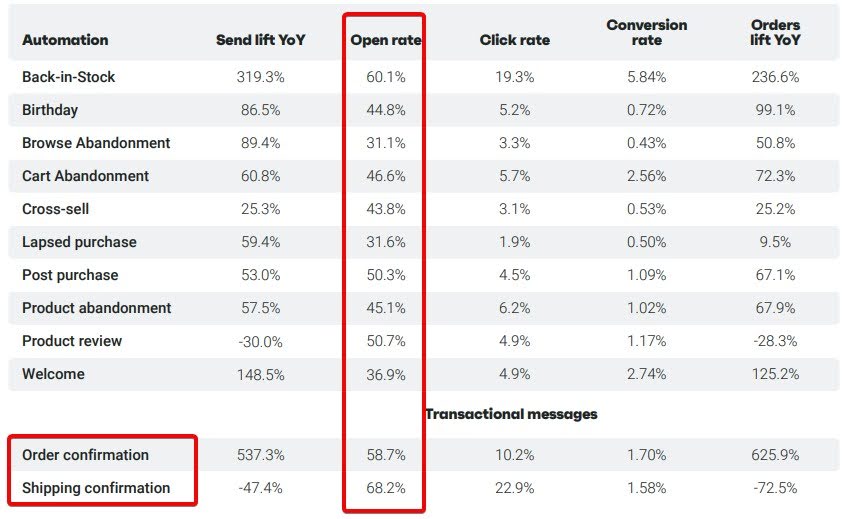
Image via Omnisend
That said, order confirmation and shipping update email flows can double as engagement magnets that:
- Build excitement around the incoming order
- Reassure customers of their order status
- Cross-sell complementary items to encourage incremental add-on sales
- Encourage customer reviews, social sharing, and word-of-mouth referrals
Let’s look at this sample email by Harry, a men’s grooming and shaving supplies company. Here, Harry’s uses its order arrival email to educate customers on how to best use its razor products. This adds value to the email instead of simply sending an order confirmation email.
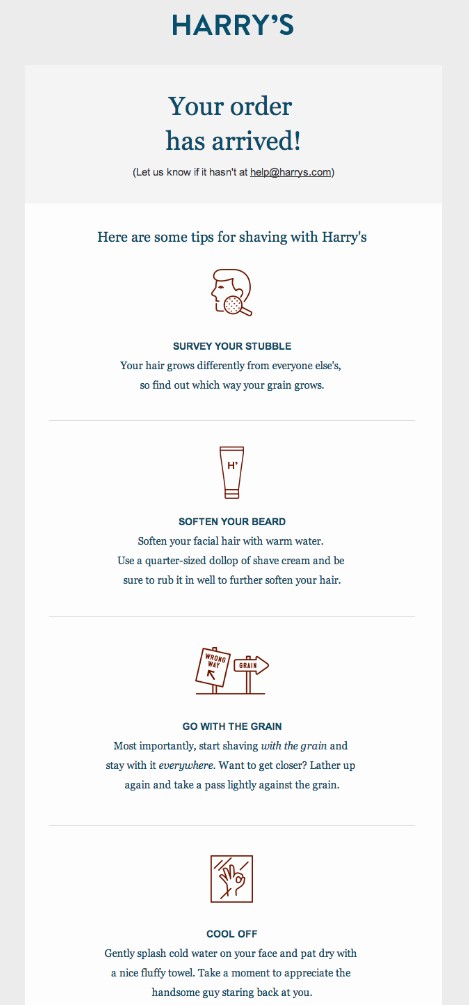
Image via Really Good Emails
Well-designed order and shipping confirmation flows pay dividends in customer loyalty and repeat purchases. They turn the post-sale experience into a lead magnet.
6. Product recommendation emails (upselling, cross-selling)
Ecommerce stores typically send these emails to showcase products that complement a buyer’s initial purchase. When done right, these recommendations can increase sales by 31%.
Brands can recommend products based on a customer’s purchase history, browsing behavior, and general preference.
For example, the bookstore Powell’s Books sends product recommendation emails to suggest books to customers. The suggested books are based on the types of books the customer likes to read. Powell’s Books sends these emails after a customer browses for books but doesn’t make a purchase.
Powell’s recommendations stand out because of their funny, witty delivery of their message. Writing with humor gets people’s attention better than bland promotional emails.
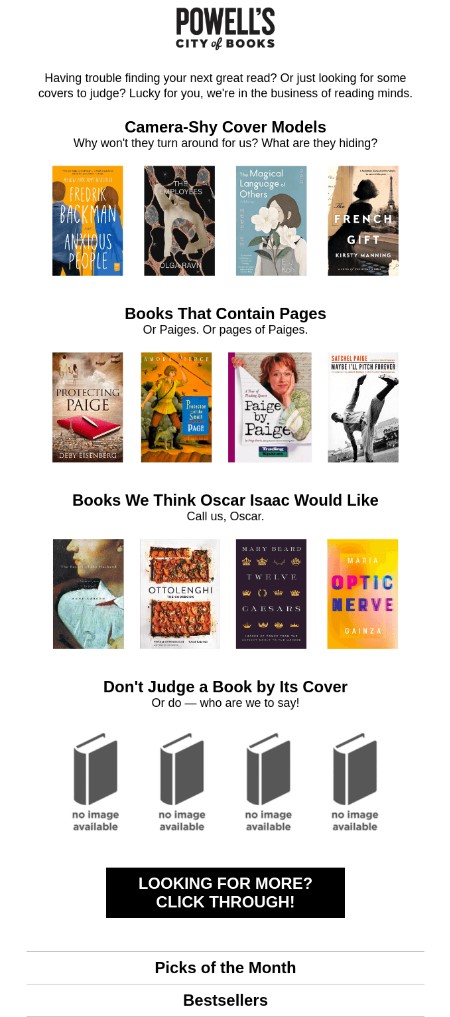
Image via Really Good Emails
That said, with proper marketing automation platform, stores can automatically send product recommendation emails:
- After someone buys something
- Along with other order emails
- Before consumables, such as skincare and food, run out.
7. Replenishment and reorder reminders
For ecommerce brands that sell consumable or perishable products, employing replenishment and reorder emails can help generate repeat sales. This is particularly true when the timing is done right.
These email reminders can be sent to existing customers when they need to replenish their stock. This provides steady sales and maximizes the total value derived from each customer.
Basically, this type of email flow prompts subscribers to stock up on items they previously bought or will soon run out of. These prompts can include:
- Refill reminders for consumables
- Recurring subscription offers for recurring purchases
- Reorder nudges for replaceable items like household supplies
- Low stock alerts for any products predicted to run out soon
Nuggs, a plant-based company selling chicken nuggets, has a good replenishment email example. The company reminds customers to buy more chicken nuggets one month after purchase. The automated email includes an easy one-click button to reorder.
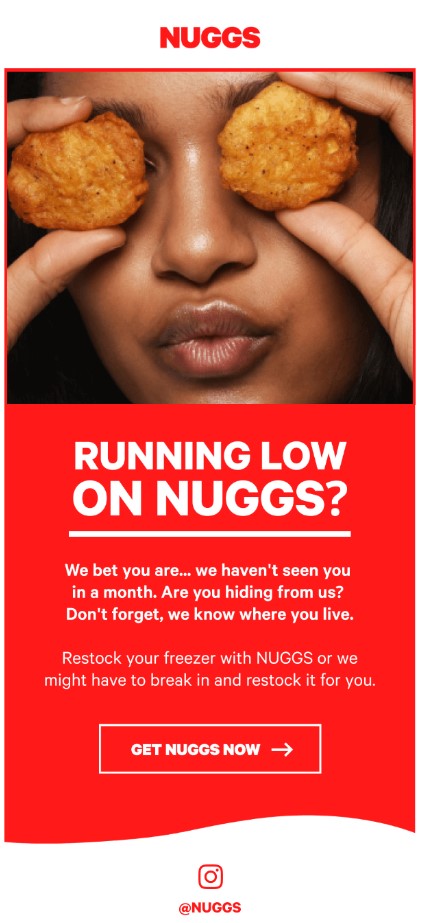
Image via Really Good Emails
By reminding customers to restock their favorite essential items, brands can build lasting customer engagement. They can also create more predictable, repeated sales.
8. Customer win-back campaigns
No matter how loyal your customer base is, some subscribers inevitably go inactive with time. It doesn’t always mean they dislike your products or services; sometimes, they just need a little nudge to respark their interest.
To reignite engagement and recover potentially lost accounts, it’s essential to set up customer win-back email flows for ecommerce companies.
Some typical win-back email flow examples include:
- “We miss you!” messages checking in on inactive subscribers
- Reminders about a customer’s most frequent purchases
- Incentives like discounts or free shipping
- Updates on new products based on interests and buying history
In this win-back email example, educational app Duolingo uses a straight-to-the-point “we haven’t seen you in a while” email. It aims to encourage dormant subscribers to pick up where they left off.
Going with this simple win-back style is ideal. This is especially true when the audience you’re trying to re-engage gets easily put off by information-heavy emails.
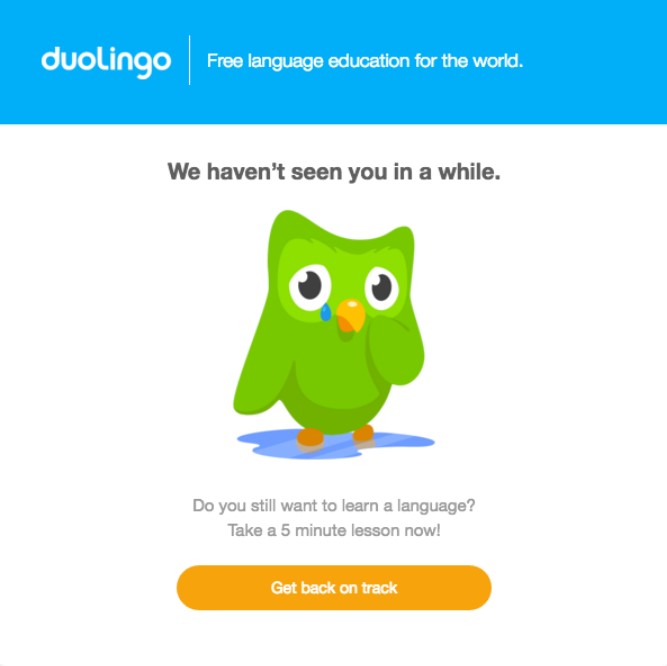
Image via Really Good Emails
Win-back email flows are very helpful for curbing natural customer churn and resurrecting valuable accounts before they’re completely lost.
9. Feedback and review requests
We can’t place enough emphasis on how important reviews from satisfied customers are in the ecommerce world. For context, a Dixa study found that a whopping 93% of shoppers will make a purchase after seeing a product’s positive review.
Sending feedback and review request emails helps you gain product insights and invaluable user-generated content. Then, you can use these as social proof in your email campaigns to boost conversions.
By tactfully requesting post-purchase feedback, you can:
- Identify unhappy customers to resolve issues promptly
- Source and amplify new positive testimonials for your marketing campaigns
- Gather a varied supply of user photos and videos for products and services
- Gain helpful product tips, hacks, and advice to enhance your support resources
Lastly, you can get better responses to your review request by providing more context and not just sending a simple request.
For instance, this review request email by Eton elicits an emotional response from environmentalists. It invites subscribers to suggest ways on how to improve its sustainability agenda. But Eton doesn’t stop there; it takes things further by incentivizing responses with a 15% discount on purchases.
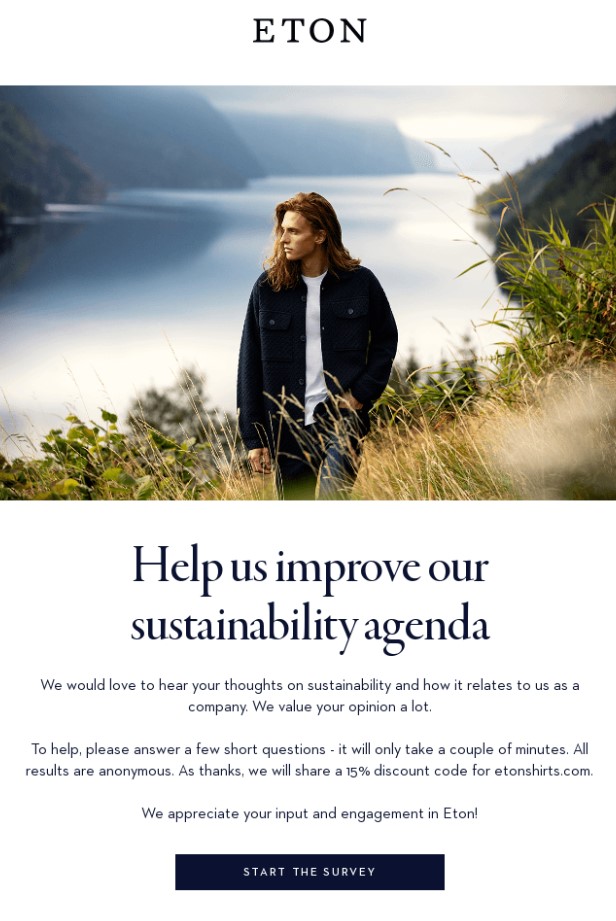
Image via Really Good Emails
The timing of your request is also very important. If you ask for reviews too early, customers may not have used the product adequately yet to form an opinion. Likewise, asking too late risks losing customers’ initial enthusiasm for your product.
That’s why we recommend waiting for 2–4 weeks after delivery before sending post-purchase review requests. You can also send survey invitations to subscribers quarterly or annually.
10. Birthday and anniversary emails
These email flows allow brands to celebrate milestones like customer birthdays or anniversaries since the first purchase. This is a great way to express appreciation, communicate exclusivity, and drive timely sales. These ecommerce email flows ultimately strengthen customer relationships and foster brand loyalty.
Here’s a colorful example of a birthday email from St. Ives. It offers a hidden promo on a selection of body care products for the subscriber on their special day. This email effectively shows appreciation for the customer while also helping St. Ives rack up more sales.
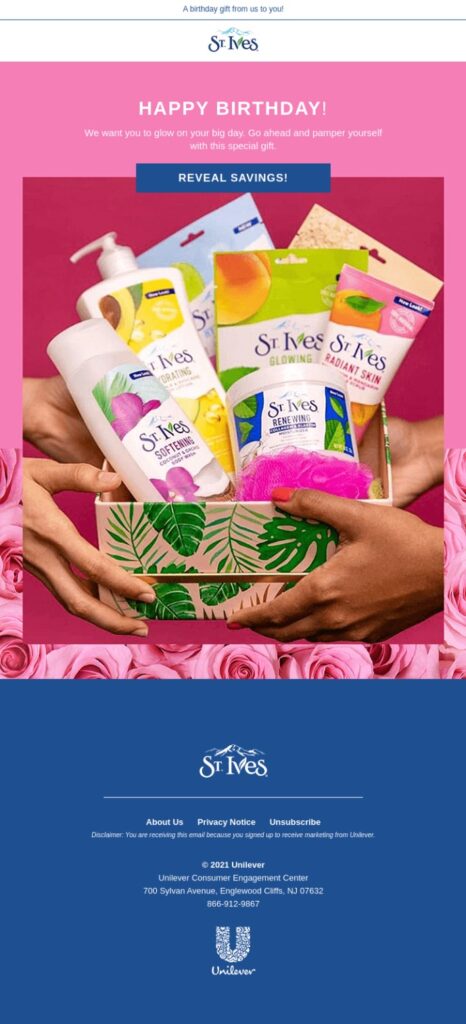
Image via Really Good Emails
Customer anniversary automated email flows commemorate key dates like:
- First-time purchases or account creation
- Loyalty program enrollment or major point milestones
- Subscription renewals or product replenishments
The example below shows Busuu celebrating a customer’s 3-month anniversary by offering 60% off their premium plans.
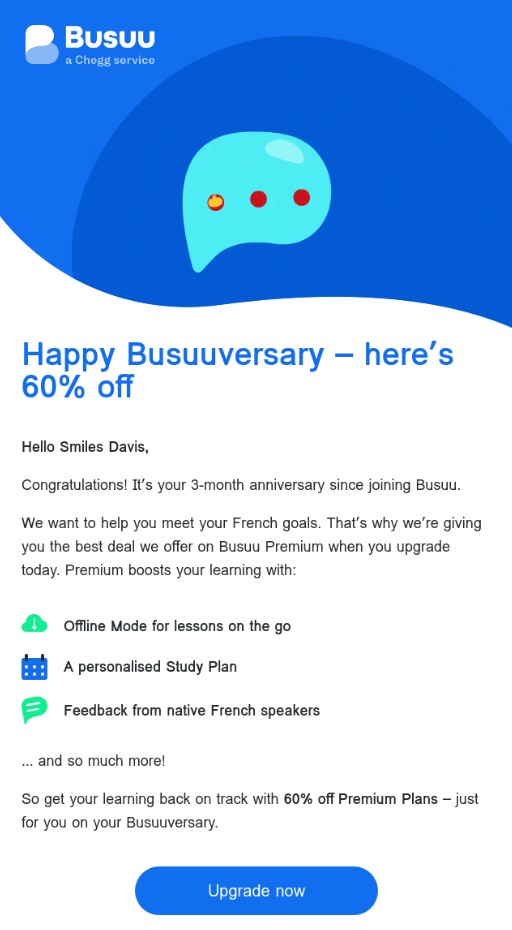
Image via Really Good Emails
Email flows: Wrap up
Automated email flows allow ecommerce companies to provide personalized experiences at scale. They also help maximize the total revenue earned from each customer relationship.
Automated email flows are great for guiding subscribers through your sales funnel. What’s more, studies show that they boost sales consistently. Apart from that, ecommerce email flows are great for building long-term customer relationships.
From welcome series to post-purchase emails, use ecommerce email flows to convert random shoppers into loyal fans. Good luck!
